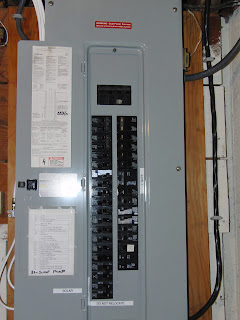After a good deal of research we decided this year to go ahead and put in Solar Photovoltaics on our roof here in Bedford. This blog describes what we did.
First, I want to thank my colleague, Christopher Mirabile, who did this over a year ago on his house, wrote the process up in detail on his blog, and also helped me understand a lot of the intricacies of the process.
Second, thanks also to EnergySage.com and their CEO, Vikram Aggarwal. I used their system to bid the project out competitively, and actually found my contractor through EnergySage.
Finally, thanks to Dave Simmer, the sales guy for Second Generation Energy, who got the contract largely because his knowledge of the industry and his attention to our needs put him above the rest of the contractors I talked to.
I should mention at this point that all three contractors with whom I spoke at any length were highly committed to renewable energy and exactly the kind of people one expects to find in this industry - intelligent and personable.
As of this writing the system is completed but awaits two final steps before going live. First the Mass Clean Energy Center (CEC) needs to bless some paperwork that authorizes various rebates and benefits. After that, NStar needs to replace our existing meter with one that can do "net metering". The existing meter would treat any electricity our roof generates and pumps into the grid like power we're using, so we'd actually get charged for it. With a net meter, if we pump power into the grid (as we will on sunny days) the meter "runs backward" and we can actually end up with the power company owing us money! Sadly one can't cash out such an excess, so it's best to stay just below that threshold.
Once the system is turned on (a few weeks from now, most likely), I'll post again to say how it went.
Sunday, June 30, 2013
Nissan Leaf
One of the things that Dave Simmer got us to think about in sizing our system was what kind of car we might get sometime. He pointed out that as owners of two elderly Prius hybrids, our next car would very likely be a plug-in of some sort, and hence sizing the system beyond our current usage (pun intended) made a lot of sense. Not only would we charge our next car for free, but we'd also be generating more SRECs in the process. Sounded good, and that's what we did.
I had visited an old friend of mine in Palo Alto and had admired his new Nissan Leaf. I looked into those here and found that they are very pleasant to drive, and make a great commuter car.
Given that both of the Priuses were around 90K miles old, it seemed like a good time to sell one of them. In fact we were able to do so on Craigslist in a day!
So we took delivery of the Leaf a couple of days later, and voila! Had to charge it on house current for the first couple of weeks until the 240v charge station got installed, but even that worked fine.
I stuffed my bike in the back and took the Leaf out to Lancaster, MA, where the internet had informed me there was a charging station behind the town hall. I found the charger there, as advertised, and plugged in before taking a nice ride down to Clinton and around Wachusett Reservoir. And apparently by law in Massachusetts public charging stations cannot charge you for the electricity they provide. How cool is that?
Here are shots of the charging station we installed in our garage, as well as a few of the Leaf.
I had visited an old friend of mine in Palo Alto and had admired his new Nissan Leaf. I looked into those here and found that they are very pleasant to drive, and make a great commuter car.
Given that both of the Priuses were around 90K miles old, it seemed like a good time to sell one of them. In fact we were able to do so on Craigslist in a day!
So we took delivery of the Leaf a couple of days later, and voila! Had to charge it on house current for the first couple of weeks until the 240v charge station got installed, but even that worked fine.
I stuffed my bike in the back and took the Leaf out to Lancaster, MA, where the internet had informed me there was a charging station behind the town hall. I found the charger there, as advertised, and plugged in before taking a nice ride down to Clinton and around Wachusett Reservoir. And apparently by law in Massachusetts public charging stations cannot charge you for the electricity they provide. How cool is that?
Here are shots of the charging station we installed in our garage, as well as a few of the Leaf.
 |
| Bike fits in the back, wheel on! |
 |
| Public charging station in Lancaster. |
Installation Photos - Panels
Inside systems installation
 |
| Here are the two SunPower inverters that receive the DC feeds from four strings of panels on the roof. |
 |
| This is the monitoring box with internet switch. |
This is the main electrical panel. The big black wire entering the box at the lower right is the AC feed from the mechanical meter, and it goes to a 50A breaker. The fat gray cable coming in at the top right houses the feeds to the two monitoring systems.
Subscribe to:
Comments (Atom)












